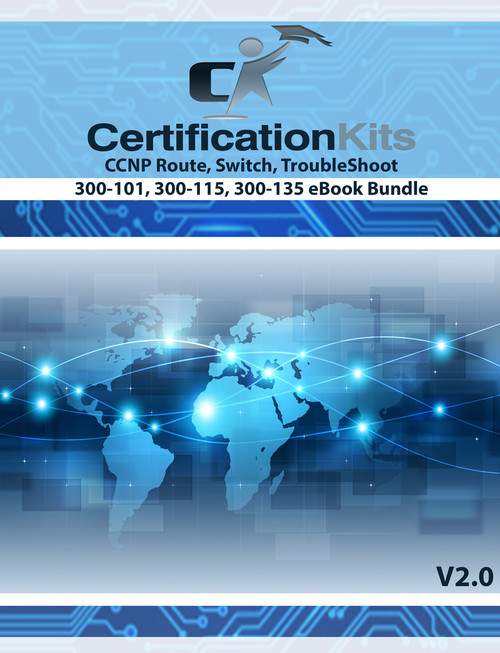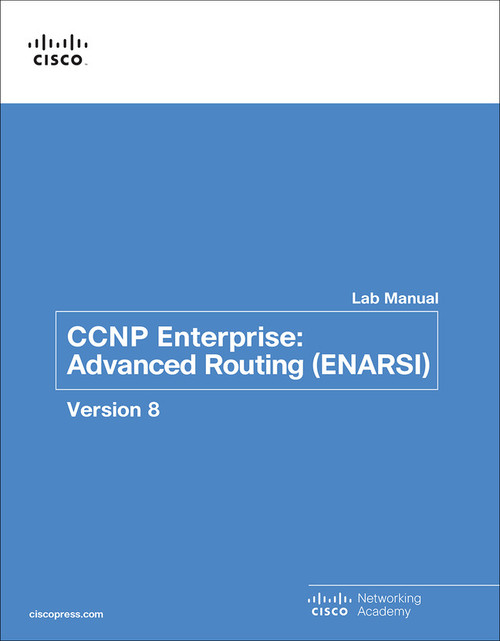CertificationKits CCNP ENARSI 300-410 Boot Camp & Theory eBook
Desktop & Mobile Compatible! IOS & Android friendly!
We are pleased to announce our new CertificationKits CCNP ENARSI 300-410 Boot Camp & Theory eBook! We know you will love our latest revision to our CCNP study guide that has been built upon through two decades of being an exceptional tool in the success of Cisco certification candidates. The CertificationKits CCNP ENARSI 300-410 Boot Camp & Theory eBook totals 991 pages of easy to read and understand content!
We have worked in collaboration with CCIEs and actual Cisco Netacad professors to ensure that we have the strongest match of knowledge meeting hands on experience with students. This was written by authors who not only know how to unlock students' capability to learn, but also know what it takes to beat that test! This CCNP study guide is 999 pages of power packed information written in an easy to understand format that maximizes your time and understanding! It not only follows the format of the new CCNP curriculum, but also works as a perfect companion to the Cisco Press CCNP ENCOR Lab Workbook.
With the latest revision of the CCNP curriculum, Cisco removed the prerequisite of having to hold a CCNA before you can take the CCNP. So, if you have some experience and are confident in your networking knowledge, you could use this as a starting point and go straight to taking the CCNP ENCOR and ENARSI exams! Once you complete CCNP ENCOR, you can move on to CCNP ENARSI to complete your CCNP Enterprise certification. CCNP ENCOR serves as the core requirements for CCNP and CCIE Enterprise. CCNP ENARSI completes the CCNP Enterprise Certification.
With this release, we even took things a step further by upgrading to our new awesome eBook reader through LockLizard. This is the same engine that Cisco actually uses to protect and distribute their corporate documents. This makes it extra cool because it is a format you will see in the field as a working network engineer. This new ebook reader works on multiple platforms such as PC, MAC, IOS, Android, etc. We include 2 activations with each purchase so you can install it on a desktop AND a mobile device, for example. On top of that you can highlight, make notes and work directly with your document.
Please feel free to check out a demo of the first chapter of this our CCNA Theory eBook. This will give you a good feel for the new reader and format of our theory eBooks:
1. Download and install the LockLizard viewer for your IOS and device type from this link: LockLizard Viewer
2. Download and install the License file for the eBook: License File
(If you don't see it open, the window for the license file may pop-up behind your active windows)
3, Download and open the .Pdc eBook file: eBook File
The download and install is very straightforward and simple, but if you get stuck, please click here for a help guide on opening your eBook demo or official purchase. Upon purchase a unique license file and a .pdc file will be emailed to you.
Table of Contents
Section 1: IP & Routing Overview
Chapter 1: IPv4/IPv6 Addressing & Troubleshooting
IPv4 Explained
Troubleshooting IPv4 Addressing Technologies
Troubleshooting DHCP for IPv4
DHCP Troubleshooting and Verification Commands
Potential DHCP Troubleshooting Issues
IPv6 Header
IPv6 Address Structure
IPv6 Address Scope Types
IPv6 Unicast Addressing
IPv6 Multicast
IPv6 Anycast
Other IPv6 features
IPv6 Routing Protocol Considerations
IPv4 to IPv6 Transition Strategies and Deployments
Overlay Tunnels
Stateful DHCPv6
Stateless Address Autoconfiguration (SLAAC)
Stateful DHCPv6 Client Configuration
Stateful DHCPv6 Server Verification
Stateless DHCPv6
Chapter 1: Questions
Chapter 2: Routing Overview & Troubleshooting
IPv4 Routing
Routing Types
IPv4 Static Routing Types
IPv6 ROUTING
IPv6 ROUTING TYPES
Default Routing
Troubleshooting Basic Routing Process
Packet-Forwarding Process
Troubleshooting Basic Routing Process
Troubleshooting Routing Information Sources
Chapter 2: Questions
Section2: EIGRP
Chapter 3: Basic EIGRP
EIGRP Introduction
EIGRP DUAL
EIGRP Metric (K-Values)
EIGRP Route Table
EIGRP load balancing
EIGRP Variance
EIGRP Reliability
Chapter 3: Questions
Chapter 4: Advanced EIGRP
Discovering Routes
Feasible Successor
Planning for EIGRP
Configuring EIGRP for IP
EIGRP Static Summarization
The EIGRP Route States and Querying Process
Why Routers Fail to Reply
Solutions to Stuck in Active
EIGRP Bandwidth Utilization
Router Authentication
Creating a Key Chain
EIGRP Commands
Chapter 4: Questions
Chapter 5: Troubleshooting EIGRP
Troubleshooting EIGRP
Troubleshooting EIGRP Neighbor Adjacencies
Causes of not forming EIGRP neighborship
Mismatched K Values
Passive Interface Issues
Troubleshooting Basic Routing Process
EIGRP Convergence
Debugging EIGRP
Chapter 5: Questions
Section 3: OSPF
Chapter 6: Basic OSPF
OSPF - Overview
OSPF Areas Concept
OSPF Terminology
OSPF DR and BDR Concept
Router ID (RID)
Types of OSPF Routers
Planning for OSPF
Configuring Single Area OSPF
OSPF Packet Types
OSPF Operational States
Link State Advertisements
Multiple Area OSPF
Summarizing Routes
Chapter 6: Questions
Chapter 7: Advanced OSPF
OSPF Areas
Configuring OSPF Areas
OSPF Virtual Links
OSPF Network Types
Point-to-Point Network
Broadcast Network
Non-Broadcast Network
OSPF Authentication
OSPF Authentication with a Virtual Link
Verifying OSPF Implementation
Chapter 7: Questions
Chapter 8: Troubleshooting OSPF
OSPF Tables
OSPF Hierarchical Routing
Neighbor Adjacencies: The Hello Packet
SPF Algorithm
OSFP Neighbors
Configuring Single Area OSPF
OSPF Verification Commands
Chapter 8: Questions
Chapter 9: OSPFv3
Introduction
OSPFv2 vs. OSPFv3
LSA Types
OSPFv3 Configurations
OSPFv3 Authentication
Chapter 9: Questions
Section 4: BGP
Chapter 10: Advanced BGP
BGP Neighbor states
IBGP
EBGP
BGP Attributes
Path Selection
AS-PATH
Next-Hop Attribute
Multi Exit Discriminator
Local Preference
WEIGHT
BGP Communities
Route Reflectors
Route Reflector Configurations
BGP Confederations
Multi-Protocol BGP for IPv6
Chapter 10: Questions
Chapter 11: Troubleshooting BGP
Introduction
Configuring BGP
Troubleshooting BGP Neighbor Adjacencies
BGP Tables
Implications of High CPU Utilization
Chapter 11: Questions
Section 5: Redistribution & Route Maps
Chapter 12: Route Redistribution
Using Multiple Routing Protocols
Redistributing Route Information
Using Seed Metrics
One Point Redistribution
One-Way and Two-Way Multipoint Redistribution
Redistribution Techniques
Redistribution Implementation Considerations
One-Way Redistribution Issue
Two-Way Multipoint Redistribution Issue
Configuring Redistribution into RIP
Configuring Redistribution into OSPF
Configuring Redistribution into EIGRP
Administrative Distance(AD)
Redistribution to Prevent Routing Loops
Chapter 12: Questions
Chapter 13: Route Maps and Conditional Forwarding
Route Filters
Distribute Lists
IP Prefix Filters
Route Maps
Route Map Operation
Configuring a Route Map
Route Map Redistribution
Filtering Routing Updates
Passive Interface
Policy-based Routing
Steps to Configure and Verify PBR
Chapter 13: Questions
Section 6: VPN
Chapter 14: MPLS
VRF-Lite
Introduction to MPLS
MPLS LIB and LFIB
Label Switching Routers
MPLS Label Format
MPLS Router Types
Label Distribution Protocol
Penultimate Hop Popping
Introduction to VPN
MPLS L3 VPN Overview
Steps to implement MPLS L3 VPN
VRF
MP-BGP
Route Distinguisher
Route Target
Chapter 14: Questions
Chapter 15: DMVPN
VPN
VPN -Types
VPN- Logical Topologies
Dynamic Multi-Point VPN
GRE - Tunnels
DMVPN - NHRP protocol
Benefits of DMVPN
DMVPN Phases
DMVPN Configuration
IPSec
IPSec - Modes
Steps for IPSec Process
DMVPN over IKEv1 IPsec
Chapter 15: Questions
Section 7: Infrastructure Security & Device Management
Chapter 16: Infrastructure Security
Securing Management Access
Authentication
Authorization
Accounting
802.1x Port-Based Authentication
Troubleshooting AAA Configurations
Unicast Reverse Path Forwarding (uRPF)
Control Plane Policing (CoPP)
ACL
Standard ACL
Extended ACL
Named ACL
Rules for Using the Access List
Creating IP Access Lists: Some Pointers
Benefits of IP Access Lists
IPv6 First-Hop Security
Chapter 16: Questions
Chapter 17: Device Management & Tools
Console Access
Telnet
SSH
Password Encryption Levels
Network Troubleshooting Tools
Conditional debugs
SNMP
Syslog
NetFlow
SPAN and RSPAN
IP SLA
Cisco DNA
Chapter 17: Questions







